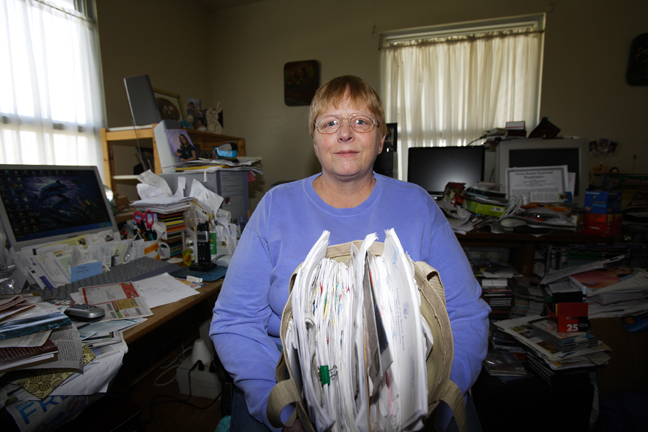In the summer of 2008, Sandra DenBraber was terrified that if she went to sleep, she might never wake up.
During those months, a carbon monoxide alarm in her home routinely went off several times a night. She believes emissions from a natural gas well at the nearby University of Texas at Arlington campus were responsible.
 She recently got some confirmation of her fears: Blood tests showed the presence of several drilling-related chemicals, including carcinogens, in her blood. And in recent months, state investigators have documented emissions of the same chemicals from the UTA gas well site, though they concluded that the levels were not high enough to constitute public health risks — a conclusion questioned by some observers.
She recently got some confirmation of her fears: Blood tests showed the presence of several drilling-related chemicals, including carcinogens, in her blood. And in recent months, state investigators have documented emissions of the same chemicals from the UTA gas well site, though they concluded that the levels were not high enough to constitute public health risks — a conclusion questioned by some observers.
DenBraber, a former occupational health nurse, moved to her neighborhood more than 24 years ago after developing severe chemical sensitivities that forced her to quit her job. She went to great lengths to make sure her environment was as free of chemicals as possible: Her home has no carpeting, no gas lines, and several heavy-duty air filtration units. She lived there in relative good health, getting by on disability payments supplemented by a small income from making and selling charcoal masks for others who suffer from the same problem.
But in 2008, in the midst of drilling operations near UTA conducted by Houston-based Carrizo Oil and Gas, her health declined rapidly. Both DenBraber and her physician, Dr. Alfred Johnson, began to suspect emissions from the well site might be responsible.
“It got to the point I wasn’t able to leave my home without getting an instant migraine,” DenBraber said. “I have an above-ground pool for exercise [following joint replacement surgeries] that I was unable to use. I couldn’t work in my garden; I couldn’t step out the door.”
The change in her health became so pronounced that both Johnson and Dr. Susan Murphy , a rehabilitation specialist at UT Southwestern Medical Center, sent letters to Carrizo on her behalf in March and April of 2008, asking that the company work with DenBraber to find a mutually agreeable solution to her situation.
“Sandy tends to react more strongly to chemical exposure than most because of her chemical sensitivity,” Johnson said. “In a sense, she’s kind of like the canary in a mineshaft.”
In response, Carrizo sent a letter offering to send DenBraber “on vacation” while the first six wells were completed. While DenBraber and her doctor were trying to find a chemically safe place she could stay, Carrizo rescinded the offer. The company did provide extra air filters for her home, DenBraber said, but the filters weren’t delivered until a few days before the wells were finished.
“Fraccing” of the first six wells was complete in August 2008. Drilling started in fall 2009 on another 16 wells, and fraccing of those is about to begin.
DenBraber said the experience left her with at least $15,000 in medical bills — and with a strong need to speak out about gas drilling dangers. Since 2008, she has been telling whoever would listen that the gas wells located at Pecan and Mitchell streets aren’t as safe as Carrizo and UTA officials have claimed. In recent weeks, she received test results confirming the presence of ethylbenzene, xylene, hexane, and methylpentanes in her bloodstream.
Last month, DenBraber received a Texas Commission on Environmental Quality analysis of an air sample collected near the UTA well site in November. The report noted the presence of benzene, toluene, ethylbenzene, and xylenes — all volatile organic compounds associated with the production of natural gas. In the report, the TCEQ analyst concluded that detected levels of the chemicals were below the threshold for short-term exposure and therefore no cause for concern.
After another resident complained of fumes coming from the site, TCEQ did a second test on Jan. 5. That time, the investigator twice detected concentrations of volatile organic compounds peaking at 15 parts per million accompanied by “a very light diesel-type odor” and lasting about five seconds. Luke Jones, a TCEQ field investigator, said concentrations that high are rare but not unheard of.
TCEQ investigators then did further monitoring by means of an infrared camera capable of detecting VOC emissions invisible to the naked eye. According to the report, the camera showed no emissions from the wells themselves, but did detect emissions from the dehydration and compressor equipment at the site, operated by DFW Midstream, a pipeline gathering company.
TCEQ investigators concluded that air sample results show VOC levels below what would affect public health.
Ashley Monts, a spokesperson with DFW Midstream, said the company has worked hard to minimize the impact of emissions and noise on the surrounding community. Monts also said the company is planning to relocate the compressor station — but couldn’t say when that would happen or whether it would be permanent.
Both Johnson and DenBraber expressed dissatisfaction with the results reached in the TCEQ analysis, claiming that the agency only evaluated short-term exposure risks to each individual chemical rather than evaluating the cumulative effect of all chemicals and long-term exposure.
David Manis, a technical specialist in TCEQ’s Field Operations Support, confirmed that the TCEQ analysis is primarily concerned with exposure effects over approximately a one-hour period. “To really get an accurate look at long-term emission levels would require longer-term monitoring — maybe a year or more,” he said.
Alisa Rich, owner of Wolf Eagle Environmental, said the sheer number of compounds detected were a concern.
“What you’re looking at here are things like benzene and toluene breaking down into their metabolites,” she said. “Some of those metabolites actually combine the qualities of a carcinogen with those of a neurotoxin.”
Like Johnson and DenBraber, Rich said the TCEQ lab analysis is flawed because it only considers individual compounds rather than looking at the cumulative effects of several chemicals.
“It’s much like a soup when you have 15 or 20 ingredients,” she said. “They all contribute to the whole.”
Rich said she is concerned about possible health effects on residents and UTA students in nearby residence halls, but that her greatest worry is the YWCA daycare facility adjacent to the well site.
Children are particularly at risk from drilling emissions, she said, in part because their breathing rates are much faster than those of adults. The increased exposure, she said, could lead to problems such as the recent leukemia cancer cluster in Flower Mound that state health officials are investigating.
Carol Kolcek, executive director of the Fort Worth and Tarrant County YWCA, said that she knows of no concerns arising from the well site.
“We’re always concerned with safety,” she said. “Being a mom myself and being responsible for the kids in our care, it’s a priority to me.”
Carrizo spokesman Michael Grimes said the university and Carrizo have been proactive in ensuring that the well site poses no risk to the community, including hiring an independent environmental science company to monitor emissions and do environmental studies.
In an e-mail, Jerry Lewis, UTA vice president for communications, said the college values its neighbors and that safety “always has been the top priority” for UTA and Carrizo. He said that air quality at the site is well within TCEQ standards, and “Any claims to the contrary are unfounded.”
Not all the local residents are reassured. Several of DenBraber’s neighbors are having their families tested for chemicals associated with drilling.
The bottom line, DenBraber said, is that some residents feel that their health and safety came in a distant second when UTA and gas companies were rushing to drill.
“It seems all they gave a damn about was the money,” she said. “My home has been turned into hell, and we’ve had nobody — absolutely nobody — protecting us.”











